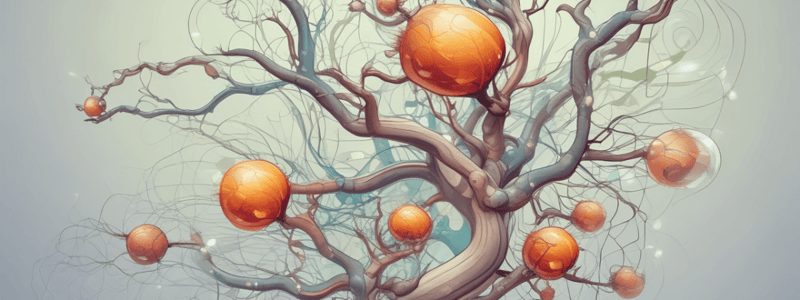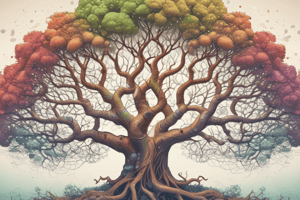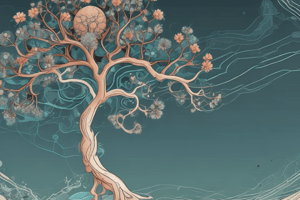Podcast
Questions and Answers
Which branch of biology studies the interactions between organisms and their environment?
Which branch of biology studies the interactions between organisms and their environment?
- Microbiology
- Zoology
- Ecology (correct)
- Botany
What is the process by which individuals with favorable traits are more likely to survive and reproduce?
What is the process by which individuals with favorable traits are more likely to survive and reproduce?
- Genotype
- Mitosis
- Natural Selection (correct)
- Speciation
What are the large molecules composed of amino acids that perform various functions?
What are the large molecules composed of amino acids that perform various functions?
- Microorganisms
- Cells
- Carbohydrates
- Proteins (correct)
Flashcards are hidden until you start studying
Study Notes
Branches of Biology
- Botany: Study of plants, including their structure, growth, evolution, and classification.
- Zoology: Study of animals, including their structure, growth, evolution, and classification.
- Microbiology: Study of microorganisms, such as bacteria, viruses, and fungi.
- Ecology: Study of the interactions between organisms and their environment.
Cell Biology
- Cell Structure: Cells consist of cell membrane, cytoplasm, and genetic material (DNA or RNA).
- Cell Functions: Cells perform functions such as metabolism, growth, reproduction, and response to stimuli.
- Cell Division: Cells reproduce through mitosis (somatic cells) or meiosis (gametes).
Genetics
- Mendelian Genetics: Study of how traits are inherited based on the principles of Gregor Mendel.
- Genotype: Genetic makeup of an organism (e.g., AABB).
- Phenotype: Physical expression of an organism's genotype (e.g., blue eyes).
Evolution
- Theory of Evolution: All species share a common ancestor and have evolved over time through natural selection.
- Natural Selection: Process by which individuals with favorable traits are more likely to survive and reproduce.
- Speciation: Formation of new species from a single ancestral species.
Ecosystems
- Ecosystem Components: Abiotic (non-living) factors (e.g., light, water, temperature) and biotic (living) factors (e.g., plants, animals, microorganisms).
- Energy Flow: Energy flows from producers (plants) to consumers (animals) through food chains and food webs.
- Nutrient Cycles: Nutrients are cycled through ecosystems through processes such as decomposition and nutrient uptake.
Biological Molecules
- Carbohydrates: Energy-rich molecules composed of carbon, hydrogen, and oxygen (e.g., glucose, starch).
- Proteins: Large molecules composed of amino acids that perform various functions (e.g., enzymes, hormones).
- Nucleic Acids: Molecules that contain genetic information (e.g., DNA, RNA).
Branches of Biology
- Botany involves the study of plant structure, growth, evolution, and classification, encompassing various aspects of plant biology.
- Zoology explores animal structure, growth, evolution, and classification, providing insights into animal diversity and characteristics.
- Microbiology delves into the world of microorganisms, including bacteria, viruses, and fungi, and their interactions with the environment.
- Ecology examines the complex relationships between organisms and their environment, shedding light on the delicate balance of ecosystems.
Cell Biology
- A cell's structure consists of a cell membrane, cytoplasm, and genetic material (DNA or RNA), which work together to maintain cellular functions.
- Cells perform various functions, including metabolism, growth, reproduction, and response to stimuli, ensuring the survival and propagation of organisms.
- Cell division occurs through mitosis (in somatic cells) or meiosis (in gametes), allowing for growth, repair, and reproduction.
Genetics
- Mendelian genetics is based on Gregor Mendel's principles, which describe how traits are inherited and expressed in organisms.
- An organism's genotype is its genetic makeup, represented by genes and alleles (e.g., AABB).
- The phenotype is the physical expression of an organism's genotype, resulting in characteristics such as blue eyes or curly hair.
Evolution
- The theory of evolution proposes that all species share a common ancestor and have evolved over time through natural selection, genetic drift, and other mechanisms.
- Natural selection is the process by which individuals with favorable traits are more likely to survive and reproduce, driving the evolution of populations.
- Speciation occurs when a new species emerges from a single ancestral species, often due to geographic isolation or other factors.
Ecosystems
- Ecosystems comprise abiotic (non-living) factors, such as light, water, and temperature, and biotic (living) factors, including plants, animals, and microorganisms.
- Energy flows from producers (plants) to consumers (animals) through food chains and food webs, supporting the complex web of life.
- Nutrient cycles, including decomposition and nutrient uptake, ensure the availability of essential resources for ecosystem components.
Biological Molecules
- Carbohydrates are energy-rich molecules composed of carbon, hydrogen, and oxygen, serving as a vital source of energy for organisms (e.g., glucose, starch).
- Proteins are large molecules composed of amino acids, performing various functions such as enzymatic reactions, hormone regulation, and structural roles.
- Nucleic acids, including DNA and RNA, contain genetic information and play a central role in the transmission of traits from one generation to the next.
Studying That Suits You
Use AI to generate personalized quizzes and flashcards to suit your learning preferences.




